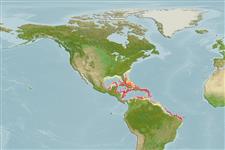>
Perciformes/Bembropoidei (Duckbill flatheads) >
Bembropidae (Duckbill flatheads)
Etymology: Bembrops: Greek, bembras, -ados = a kind of anchovy m+ Greek, ops = appearance (Ref. 45335); macromma: Specific name from the Greek 'makros' meaning large and 'omos' meaning shoulder.
More on author: Ginsburg.
Environment: milieu / climate zone / depth range / distribution range
Écologie
marin bathydémersal; profondeur 150 - 550 m (Ref. 13203), usually 250 - ? m (Ref. 13203). Deep-water
Western Central Atlantic: Gulf of Mexico and the Caribbean Sea.
Taille / Poids / Âge
Maturity: Lm ? range ? - ? cm
Max length : 23.2 cm SL mâle / non sexé; (Ref. 13203)
Épines dorsales (Total) : 6; Rayons mous dorsaux (Total) : 14 - 15; Rayons mous anaux: 17 - 18. Caudal fin with dark gray pigmentation along entire posterior edge and scales absent in small area in front of eye. Snout relatively short, 0.8-1.4x eye diameter. Scales on lateral and dorsal sides of snout in most specimens. A small area in front of eye without scales in most specimens. Upper jaw extending behind anterior margin of eye reaching almost to its mid-line. Maxillary tentacle short and stubby. Lateral line descending gradually, reaching mid-line at tip of pectoral fin, separated from origin of first dorsal fin by 3-5 rows of scales, from origin of anal fin by 5-7, and from insertion of anal fin by 2 or 3. Second spine of first dorsal fin prolonged in some specimens. Pectoral fin pointed in most specimens (Ref 13203).
Female specimens collected in May have mature gonads (Ref. 13203).
Life cycle and mating behavior
Maturité | Reproduction | Frai | Œufs | Fécondité | Larves
Das, M.K. and J.S. Nelson, 1996. Revision of the percophid genus Bembrops (Actinopterygii: Perciformes). Bull. Mar. Sci. 59(1):9-44. (Ref. 13203)
Statut dans la liste rouge de l'IUCN (Ref. 130435: Version 2024-2)
Menace pour l'homme
Harmless
Utilisations par l'homme
Outils
Articles particuliers
Télécharger en XML
Sources Internet
Estimates based on models
Preferred temperature (Ref.
123201): 11.1 - 18.9, mean 15.1 °C (based on 36 cells).
Phylogenetic diversity index (Ref.
82804): PD
50 = 0.5000 [Uniqueness, from 0.5 = low to 2.0 = high].
Bayesian length-weight: a=0.00380 (0.00157 - 0.00921), b=3.11 (2.91 - 3.31), in cm total length, based on LWR estimates for this (Sub)family-body shape (Ref.
93245).
Niveau trophique (Ref.
69278): 4.1 ±0.5 se; based on size and trophs of closest relatives
Fishing Vulnerability (Ref.
59153): Low vulnerability (18 of 100).
